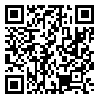Volume 14, Issue 1 (Spring 2022)
2022, 14(1): 9-18 |
Back to browse issues page
Ethics code: IR.ZUMS.REC.1400.053
Download citation:
BibTeX | RIS | EndNote | Medlars | ProCite | Reference Manager | RefWorks
Send citation to:



BibTeX | RIS | EndNote | Medlars | ProCite | Reference Manager | RefWorks
Send citation to:
Javadi V, Saed O. The Effectiveness of Cognitive-Behavioral Therapy on Anxiety Disorders in Iranian Children and Adolescents: A Systematic Review. North Khorasan University of Medical Sciences 2022; 14 (1) :9-18
URL: http://journal.nkums.ac.ir/article-1-2561-en.html
URL: http://journal.nkums.ac.ir/article-1-2561-en.html
1- MS student of Clinical Psychology, Department of Clinical Psychology, School of Medicine, Zanjan University of Medical Sciences, Zanjan Iran
2- Assistant professor, Department of Clinical Psychology, School of Medicine, Zanjan University of Medical Sciences, Zanjan, Iran ,o.saed@zums.ac.ir
2- Assistant professor, Department of Clinical Psychology, School of Medicine, Zanjan University of Medical Sciences, Zanjan, Iran ,
Abstract: (3481 Views)
Introduction: Anxiety disorders are one of the most common disorders in childhood and adolescence. Given the consequences of these disorders on the academic, family, and social performance of children and adolescents, identifying the most effective psychological interventions for these disorders is more important. The purpose of this study is to review the studies on the effectiveness of cognitive-behavioral therapy on anxiety disorders in children and adolescents in Iran.
Method: In this systematic review, 54 studies from three databases, including Magiran، SID، Noormags, on the effectiveness of cognitive-behavioral therapy on anxiety disorders in children and adolescents from 2009 to 2019 in Iran were collected, and 27 studies were selected after evaluation and compliance with inclusion and exclusion criteria and the Strobe checklist. Eventually, 14 of them were studied in total and 13 in summary.
Results: In these studies, 1000 children and adolescents have been studied. The findings showed that in most studies, the reported effect size ranged from 0.15 to 0.48, which is a moderate effect size for the effectiveness of treatment. All the studied studies had several theoretical and methodological problems. Some of these common problems: Poor or incomplete comparison with similar previous studies, poor explanations provided for treatment effectiveness, low sample size, useless advanced statistical formulas, and lack of reference to methods, not to mention the methods of monitoring treatment. Also, in most of these studies, the principles and guidelines of the International Standard Clinical Trial were not followed.
Conclusion: The results of the reviewed studies indicate the low to moderate effectiveness of intervention protocols, but it seems that if the theoretical and methodological problems of these studies in Iran are resolved, a more accurate estimate of the efficacy of cognitive-behavioral therapy for anxiety disorders in children and adolescents can be made.
Method: In this systematic review, 54 studies from three databases, including Magiran، SID، Noormags, on the effectiveness of cognitive-behavioral therapy on anxiety disorders in children and adolescents from 2009 to 2019 in Iran were collected, and 27 studies were selected after evaluation and compliance with inclusion and exclusion criteria and the Strobe checklist. Eventually, 14 of them were studied in total and 13 in summary.
Results: In these studies, 1000 children and adolescents have been studied. The findings showed that in most studies, the reported effect size ranged from 0.15 to 0.48, which is a moderate effect size for the effectiveness of treatment. All the studied studies had several theoretical and methodological problems. Some of these common problems: Poor or incomplete comparison with similar previous studies, poor explanations provided for treatment effectiveness, low sample size, useless advanced statistical formulas, and lack of reference to methods, not to mention the methods of monitoring treatment. Also, in most of these studies, the principles and guidelines of the International Standard Clinical Trial were not followed.
Conclusion: The results of the reviewed studies indicate the low to moderate effectiveness of intervention protocols, but it seems that if the theoretical and methodological problems of these studies in Iran are resolved, a more accurate estimate of the efficacy of cognitive-behavioral therapy for anxiety disorders in children and adolescents can be made.
Keywords: Cognitive-Behavioral Therapy, Anxiety Disorders, Children and Adolescents, Systematic Review, Iran
Type of Study: Review Article |
Subject:
Basic Sciences
Received: 2021/09/19 | Accepted: 2022/02/1 | Published: 2022/05/31
Received: 2021/09/19 | Accepted: 2022/02/1 | Published: 2022/05/31
Send email to the article author
| Rights and permissions | |
 |
This work is licensed under a Creative Commons Attribution-NonCommercial 4.0 International License. |







